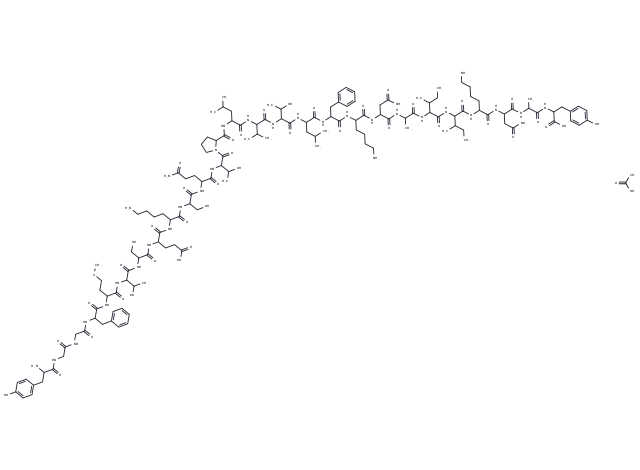Shopping Cart
- Remove All
 Your shopping cart is currently empty
Your shopping cart is currently empty

β-Endorphin (1-27) (human) acetate, existing in the hypophysis cerebri and hypothalamus, exhibits antinociception activity. β-Endorphin (1-27) (human) acetate is an agonist of opioid receptor, showing preferred affinity for μ-opioid receptor and δ-opioid

| Pack Size | Price | Availability | Quantity |
|---|---|---|---|
| 1 mg | $117 | In Stock | |
| 2 mg | $165 | In Stock | |
| 5 mg | $262 | In Stock | |
| 10 mg | $388 | In Stock | |
| 25 mg | $592 | In Stock | |
| 50 mg | $828 | In Stock | |
| 100 mg | $1,110 | In Stock | |
| 200 mg | $1,480 | In Stock |
| Description | β-Endorphin (1-27) (human) acetate, existing in the hypophysis cerebri and hypothalamus, exhibits antinociception activity. β-Endorphin (1-27) (human) acetate is an agonist of opioid receptor, showing preferred affinity for μ-opioid receptor and δ-opioid |
| In vitro | β-Endorphin (1-27) (human) acetate inhibits the conduction of pain and agitation of nociceptors to exert an analgesic effect. β-Endorphin (1-27) (human) acetate combines together with the opioid receptors in hyperalgesia. β-Endorphin (1-27) (human) acetate suppresses the release of substance P at the level of spinal cord and blocks the conduction of pain on the primary sensory neurons. β-Endorphin (1-27) (human) acetate activates the endogenous analgesia system located in the CNS[1]. |
| Alias | β-Endorphin (1-27) (human) acetate(76622-84-9 Free base) |
| Molecular Weight | 3082.52 |
| Formula | C141H221N33O42S |
| Smiles | CCC(C(NC(C(NC(C(NC(C(NC(C(NC(C(NC(C(NC(C(NC(C(NC(C1CCCN1C(C(NC(C(NC(C(NC(C(NC(C(NC(C(NC(C(NC(C(NC(C(NC(CNC(CNC(C(N)CC2=CC=C(O)C=C2)=O)=O)=O)CC3=CC=CC=C3)=O)CCSC)=O)C(O)C)=O)CO)=O)CCC(O)=O)=O)CCCCN)=O)CO)=O)CCC(N)=O)=O)C(O)C)=O)=O)CC(C)C)=O)C(C)C)=O)C(O)C)=O)CC(C)C)=O)CC4=CC=CC=C4)=O)CCCCN)=O)CC(N)=O)=O)C)=O)C(NC(C(NC(C(NC(C(NC(C(NC(C(O)=O)CC5=CC=C(O)C=C5)=O)C)=O)CC(N)=O)=O)CCCCN)=O)C(CC)C)=O)C.CC(O)=O |
| Storage | keep away from moisture | Powder: -20°C for 3 years | In solvent: -80°C for 1 year | Shipping with blue ice. |

Copyright © 2015-2024 TargetMol Chemicals Inc. All Rights Reserved.